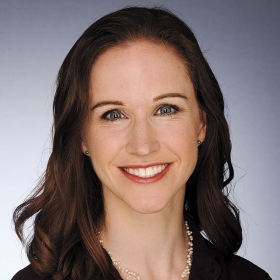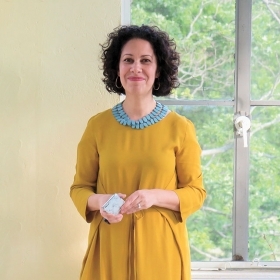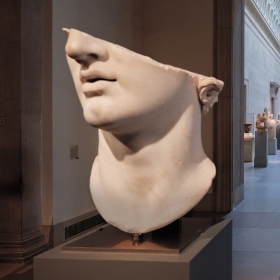Abigail Gardner Athanasopoulos ’02
When you’re an art history major deeply immersed in 19th-century painting, it might seem unlikely that assessing the value of Coney Island memorabilia is in your future. But that’s what happened for Abby Gardner Athanasopoulos ’02, the founder of Spectrum Appraisals.

When you’re an art history major deeply immersed in 19th-century painting, it might seem unlikely that assessing the value of Coney Island memorabilia is in your future. But that’s what happened for Abby Gardner Athanasopoulos ’02, the founder of Spectrum Appraisals.
After graduating from Wellesley, Abby moved to New York City and found work in a gallery focused on American art. She spent a few years there before deciding it wasn’t the right fit. The gallery was fun, she says, but it was still sales, and she didn’t want to work in sales. When she saw an appraisal studies program in the course catalog for NYU’s School of Professional Studies, a lightbulb went on. At Wellesley, Abby had considered majoring in math or economics. Appraising would combine her interests. Abby took the course at NYU.
“I actually found a job working for my mentor of many, many years through another Wellesley alum, who was working for her at the time,” she says. Abby had reached out to the alum to network, and she suggested Abby apply for her position, since she was moving on. Abby started work at Appraisal Resource Associates in 2005. “I was there until going out on my own,” she says.
Abby had been thinking about starting her own firm when COVID hit, and it felt like a logical time to make the transition. It’s been a renewing experience, she says. “The work—it’s so funny—it feels so different when you’re doing it for yourself versus when you’re doing it for someone else.” The work is essentially the same, she says, but being responsible for everything feels special.
Most of the appraisals she does through Spectrum are for insurance coverage, insurance claims, charitable contributions, or estate tax reporting. “I also do appraisals as consultations for possible sale or purchase, and estate planning,” Abby says. She adds that students interested in art history should consider appraising an option. “There’s a little bit of writing. There’s a little bit of research. There’s client interaction. It’s very multifaceted, and [you’re] always dealing with different properties,” she says.
Some of Abby’s recent projects include the interior of a Greek Orthodox church in Manhattan—icons painted in situ that needed appraising for insurance purposes—and that Coney Island memorabilia. On projects like these, it’s not a straightforward matter of finding comparable work by the same artist, which is how an appraiser would approach something like a Picasso print. “There are different approaches to value, and it gets kind of complex. But it keeps it interesting, too,” Abby says.
For Coney Island memorabilia like original carousel horses, “It’s not necessarily who carved the horse that’s a significant characteristic of value,” she explains. “Really, the value was based on the fact that it was part of Coney Island and New York City history.”
On another occasion, Abby was tasked with couriering a painting signed by Bruegel to Europe for authentication. “The one expert who authenticated works by Bruegel was in a little, remote German farm town,” she recalls. He was elderly, in a wheelchair, and unable to travel. “If you wanted him to authenticate a painting, you had to bring it to him,” Abby says. Over about a day, she flew to Germany with the painting tucked next to her on the plane and took a car ride to the expert’s house, where he authenticated the Breugel. She got a little tour, spent the night in the airport hotel, and came home.
Would this have been as much of an adventure if the painting hadn’t been authentic? “I still would have had fun, but that was definitely icing on the cake,” Abby says.


